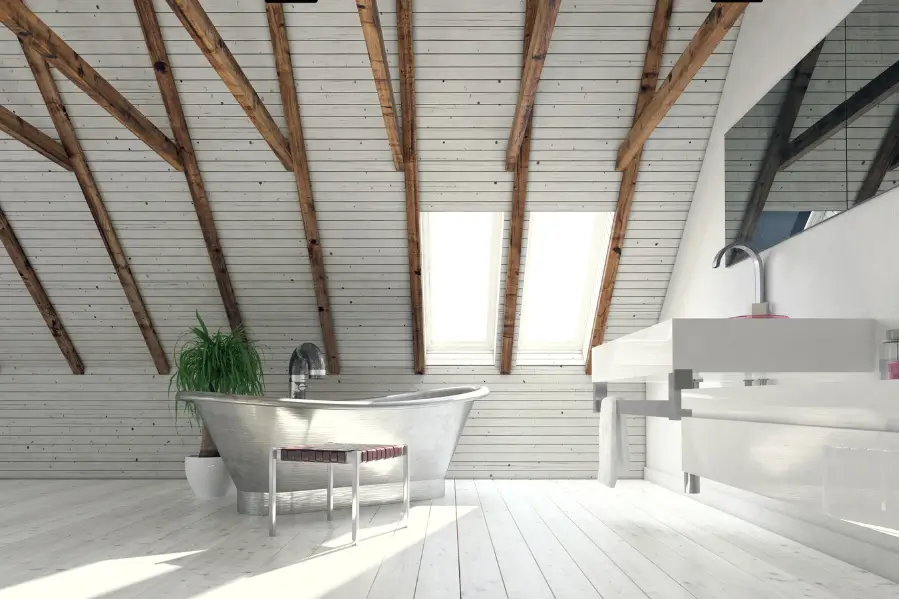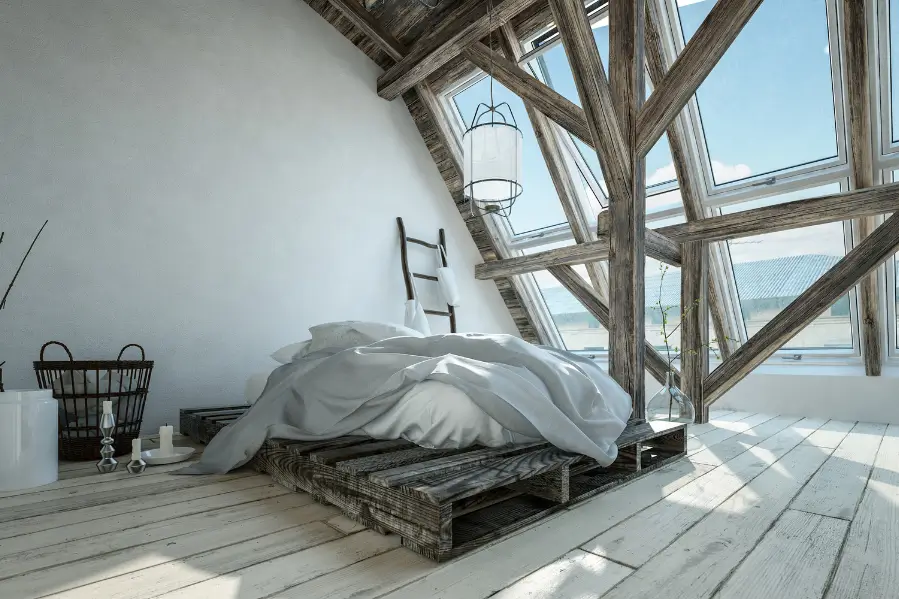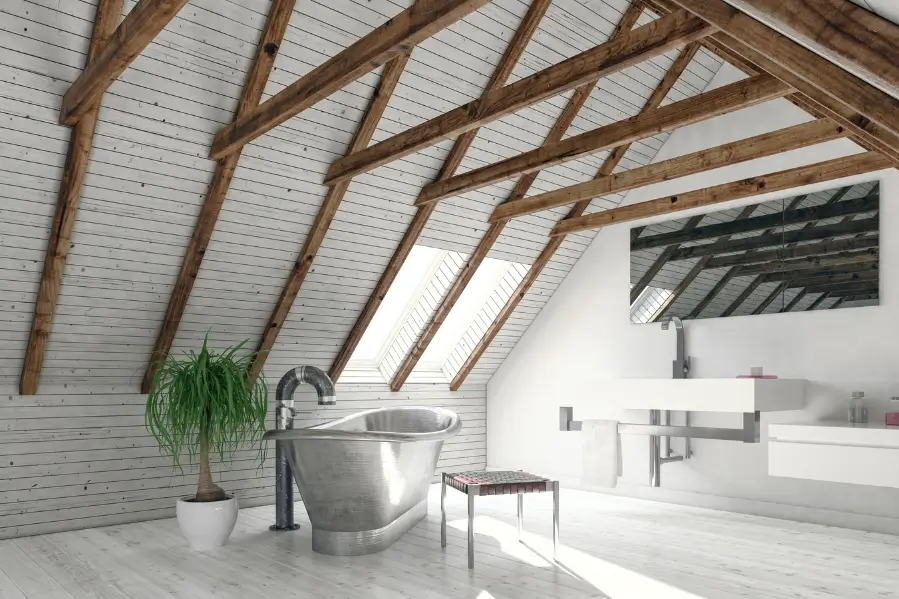Attic conversion into a functional space seems to be a trend these days. You can convert your attic to a home office area, bedroom, playroom or a studio. So, it is one of the great home improvement projects.
Homeowners often wonder whether such a conversion adds value to their property. Well, the short answer is Yes. Something that enhances a property will also add value to it and make your property more attractive to potential buyers.
This article explores the financial, practical, and aesthetic benefits of attic conversions. So, you will get a valuable insight if you are considering this renovation. So, let’s begin.
How Much Value Does a Loft Conversion Add to a House?

A loft conversion can add significant value to a house in various ways. Here are some of the key benefits and value additions:
1. Financial Value
If we talk about financial value, loft conversions can increase property value by 10% to 20%. However, the overall exact percentage depends on location, quality of the conversion, and the type of property.
Financially, loft conversions are a sound investment. They provide a return on investment (ROI) of around 50% to 75%. In high-demand areas, this ROI can be even higher, which makes loft conversions an attractive option for homeowners who want to maximize their property’s value and appeal.
Loft conversion also offers an attractive selling point. Homes that have additional living spaces, such as loft conversions, tend to sell faster and at higher prices because buyers are typically drawn to the extra space and potential uses.
2. Functional Value
As loft conversions are additional spaces in the home that can be used flexibly as extra bedrooms, home offices, playrooms, guest rooms, or studios. So, it adds significant functional value to a home.
For growing families, the extra bedrooms or play areas are particularly valuable, while the addition of a dedicated home office is increasingly important in the era of remote work. This makes the home more adaptable to the evolving needs of its occupants and improves everyday living conditions.
3. Aesthetic and Design Value
Loft conversions often bring a modern touch to homes. It is because we add contemporary features like skylights, dormer windows, and innovative storage solutions, which enhance the overall aesthetic appeal. The increase in natural light from skylights and large windows makes the converted space more inviting and pleasant. Additionally, a well-designed loft conversion can seamlessly integrate with the existing architecture and improve it.
What is the Cost of a Loft Conversion?

The cost of a loft conversion can vary widely based on several factors, including the type of conversion, the size of the loft, the complexity of the project, the time duration, the quality of materials used, and the region where you live.
Here’s a breakdown of the main types of loft conversions and their approximate costs in the UK:
1. Roof Light Loft Conversion
Cost: £15,000 to £25,000
This is the simplest and cheapest type of loft conversion. It mainly involves the installation of windows into the existing roof slope.
Pros
- Minimal structural changes required.
- Quicker to complete.
- Least expensive option.
- Least disruptive to existing structure and occupants.
Cons
- Limited increase in usable space.
- Roof slope may restrict headroom and usable floor area.
- May not be suitable for all lofts, particularly if the existing height is insufficient.
2. Dormer Loft Conversion
Cost: £30,000 to £50,000
Dormer loft conversion involves extending the roof to add more space with dormer windows. It is the most common type of loft conversion.
Pros
- It increases headroom and usable floor space.
- Versatile. You can connect this loft to most types of houses.
- Can add significant value to the property.
Cons
- More structural changes are required compared to a roof light conversion.
- Requires planning permission in some cases.
- Potentially more disruptive than a roof light conversion.
3. Hip to Gable Loft Conversion
Cost: £40,000 to £65,000
Gable loft conversion changes a sloping (hipped) roof to a vertical wall (gable end) to create more internal space. This type of conversion is common in semi-detached and end-of-terrace houses.
Pros
- Substantially increases internal space.
- Provides more options for room layouts.
- Enhances the exterior appearance of the house.
Cons
- Significant structural changes required.
- More expensive than dormer and roof light conversions.
- Requires planning permission and may affect neighboring properties.
4. Mansard Loft Conversion
Cost: £45,000 to £70,000
Mansard attic conversion involves altering the roof structure to create a nearly vertical wall with a flat roof, usually at the rear of the property. It’s common in terraced houses.
Pros
- Maximizes usable space in the loft.
- Allows for the creation of large, light-filled rooms.
- Can significantly increase property value.
Cons
- Most expensive and complex type of loft conversion.
- Requires major structural work.
- Almost always requires planning permission.
5. Modular Loft Conversion
Cost: £40,000 to £70,000
A modular loft conversion is prefabricated off-site and then assembled on your property. It’s a modern and efficient method.
Pros
- Reduced on-site construction time.
- Consistent quality due to factory-controlled conditions.
- Less disruption to the household during construction.
Cons
- Limited customization options compared to traditional methods.
- Requires precise measurements and planning.
- May involve complex logistics for delivery and installation.
What Happens If I Don’t Own the Attic Space?
If you don’t own the attic space, there are several important steps you need to take before proceeding with a loft conversion:
1. Determine Ownership
First, confirm the ownership of the attic space. This can be checked through the property deeds or lease agreement. In some cases, the attic space might be part of a communal area in a building, especially in leasehold properties or flats.
2. Leasehold Properties
If you are a leaseholder, the freeholder (or landlord) typically owns the attic space. Here are the steps you need to take:
- Get Permission: You will need to get formal permission from the freeholder to convert the loft. This may involve negotiating terms and potentially paying a fee.
- Lease Extension or Purchase: Sometimes, you can negotiate an extension of your lease to include the attic space or even purchase the attic space outright from the freeholder. This would likely require a formal evaluation and legal work.
- Legal Advice: It is advisable to seek legal advice to ensure that all agreements are properly documented and legally binding.
3. Share of Freehold
If you are in a building with a share of the freehold, the process might be simpler, but you will still need to get consent from the other freeholders and your neighbors as well.
Obtain written agreement from all parties sharing the freehold. This may involve drawing up a legal agreement to define the terms and any compensation or contributions to communal funds.
4. Planning Permission
Regardless of ownership, you will likely need planning permission for the loft conversion. This is particularly true if the building is listed, in a conservation area, or if the conversion significantly alters the building’s external appearance.
5. Building Regulations Approval
All loft conversions require building regulations approval to ensure the new space meets safety and structural standards. This includes fire safety, insulation, and structural integrity.
6. Party Wall Agreement
If your loft conversion affects a wall shared with a neighbor (a party wall), you will need a Party Wall Agreement. This is particularly relevant in terraced or semi-detached houses.
7. Insurance
Check with your insurance provider to see if the loft conversion will affect your home insurance policy. You may need additional coverage during and after the construction.
8. Survey and Structural Assessment
Conduct a structural survey to ensure that the building can support the additional load of the loft conversion. This may identify any necessary reinforcements or modifications.
Trusted Experts for Your Attic Conversion Needs in Houston
For those in the Houston area looking to undertake attic conversion project, consider getting the services of Smart Remodeling LLC. The company specializes in both home and commercial remodeling services, including attic conversions.
With their expertise and commitment to quality, Smart Remodeling LLC can help transform your attic into a valuable and attractive space that enhances your home’s overall appeal and functionality.
Wrap Up
Attic conversions offer a multitude of benefits, both financial and practical that make them an excellent home improvement project for many homeowners. Whether opting for a simple roof light conversion or a more elaborate mansard conversion, the key is to balance cost, functionality, and aesthetic appeal to maximize the return on investment.
So, are you ready to transform your attic and boost your home’s value? Contact Smart Remodeling LLC today!






